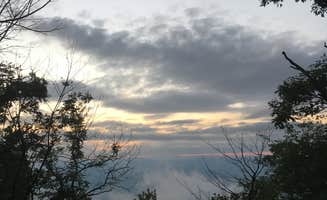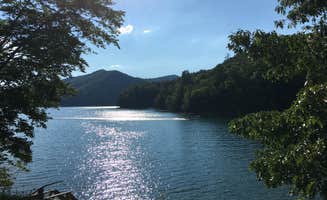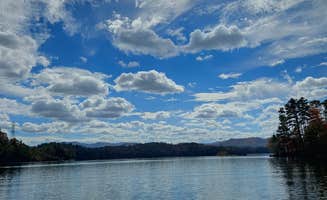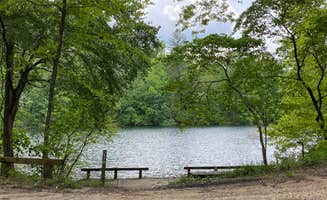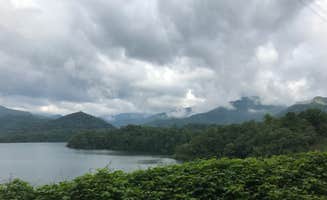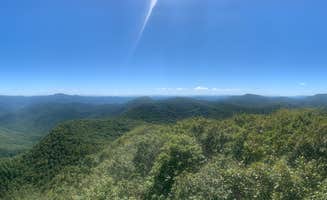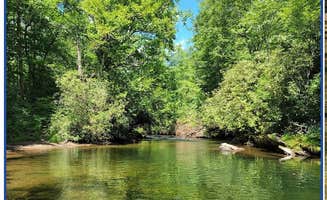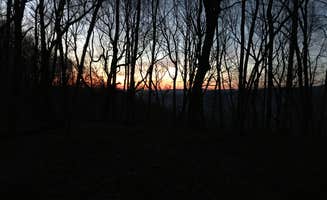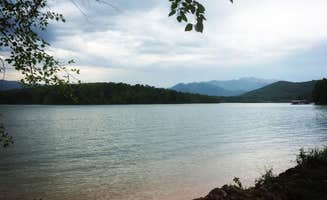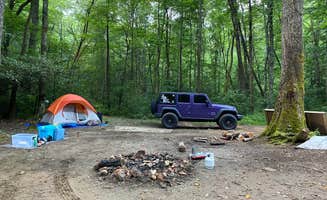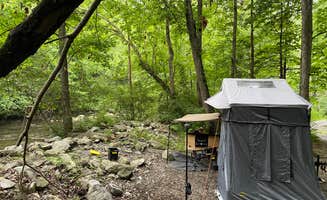Dispersed camping near Almond, North Carolina centers around the southwestern corner of Nantahala National Forest, with elevations ranging from 1,800 to 5,000 feet. The region experiences mild summers with average temperatures in the 70s and cooler evenings in the 50s. Fall camping season typically extends through late October, with occasional early snow at higher elevations.
What to do
Fishing opportunities: Several sites at Lake Santeetlah Dispersed provide excellent bank fishing. "The fishing wasn't bad at all. Bass and Bluegills," reports one camper, who noted the easy access to the water from their site.
Hiking to fire towers: Moderately challenging trails lead to panoramic views. "We always do this hike for sunrise since it is a quick trek up and gives the best views of the area," shares a visitor to Wesser Bald Fire Tower, who recommends bringing a hammock for overnight stays rather than a tent.
Paddle sports: Many lake sites accommodate small watercraft. "You are right in the little slickrock cover with waterfalls as white noise," writes a camper at Calderwood Lake Primitive Campground, noting the easy 30-minute paddle from the Magazine Branch boat dock to the first campsite.
What campers like
Lake access: Direct water frontage ranks as a top feature. At Lake Santeelah Dispersed, one visitor notes, "We were fortunate to get a site that allowed us to pull the car right into the site for our roof top tent. Not very far to walk to reach the lake."
Privacy between sites: The layout of many areas offers seclusion. At Long Hungry Road Dispersed Campsites, a camper shared, "8 or so beautiful sites, many with direct lake views/access," pointing out that "many of the sites do not allow drive in."
Established amenities: Despite being primitive, some sites include basic infrastructure. "This is the most established dispersed campsite that I've stayed at as it has a fire circle, a grill and a picnic table," reports a Long Hungry Road visitor.
What you should know
Site availability challenges: Competition for spots intensifies on weekends. A Long Hungry Road camper noted, "Showed up around 2:30-3 o'clock on a Sunday afternoon and most of the spots were already called for. Seems you gotta get there early if you want easy water access."
Navigation difficulties: Finding turnoffs can be confusing, especially after dark. "The sign at the road looks like it was either taken down or blew away. The pin drop doesn't take you to the turn in on google or Apple Maps," explained a visitor to Long Hungry Road.
Cell service limitations: Coverage varies dramatically by location. One Lake Santeelah camper reported, "Zero signal at both areas for Verizon and T-Mobile," while others found limited service at higher elevations.
Resource management: Pack everything needed for your stay. At Albert Mountain Firetower Dispersed Campsite, a visitor warned, "The camp site itself is very rustic, no amenities other than a rock fire ring, and does not face the vistas."
Tips for camping with families
Choose sites with flat terrain: Some areas offer more level ground than others. A camper at Siler Bald Trail Shelter TR 373 advised, "Closest shelter to the bald where you can get an amazing view. Well cared for and in an incredible area. Just be prepared for a climb to see the view."
Consider site spacing: Allow buffer between your group and others. At Lake Santeetlah, one reviewer observed the site arrangement provides good separation: "Sites are very well laid out and maintained!"
Plan for weather changes: Mountain conditions can shift rapidly. Bring layers and rain gear, especially during fall when temperature swings of 30+ degrees between day and night are common.
Scout water access safety: Lake edges vary in steepness. At Lake Santeelah, some sites have gradual entries while others feature steep drop-offs that may not suit younger children.
Tips from RVers
Size limitations: Most dispersed sites accommodate smaller rigs only. "The sites were amazing, beautiful views, lake access, nice fire pits, good tent pads," notes a visitor to Lake Santeetlah, emphasizing these are primarily designed for tents.
Road conditions: Forest access roads require careful driving. One camper at Lake Santeetlah recommended high-clearance vehicles: "If you do come driving through the Coweeta Hydrological Laboratory path, be prepared for narrow, steep gravel lanes."
Limited turnaround space: Plan your approach carefully. A Long Hungry Road camper noted that "at the end of the road there is a turn around space if needed," but warned most sites have limited parking that "could fit camper van or tiny trailer" at best.


